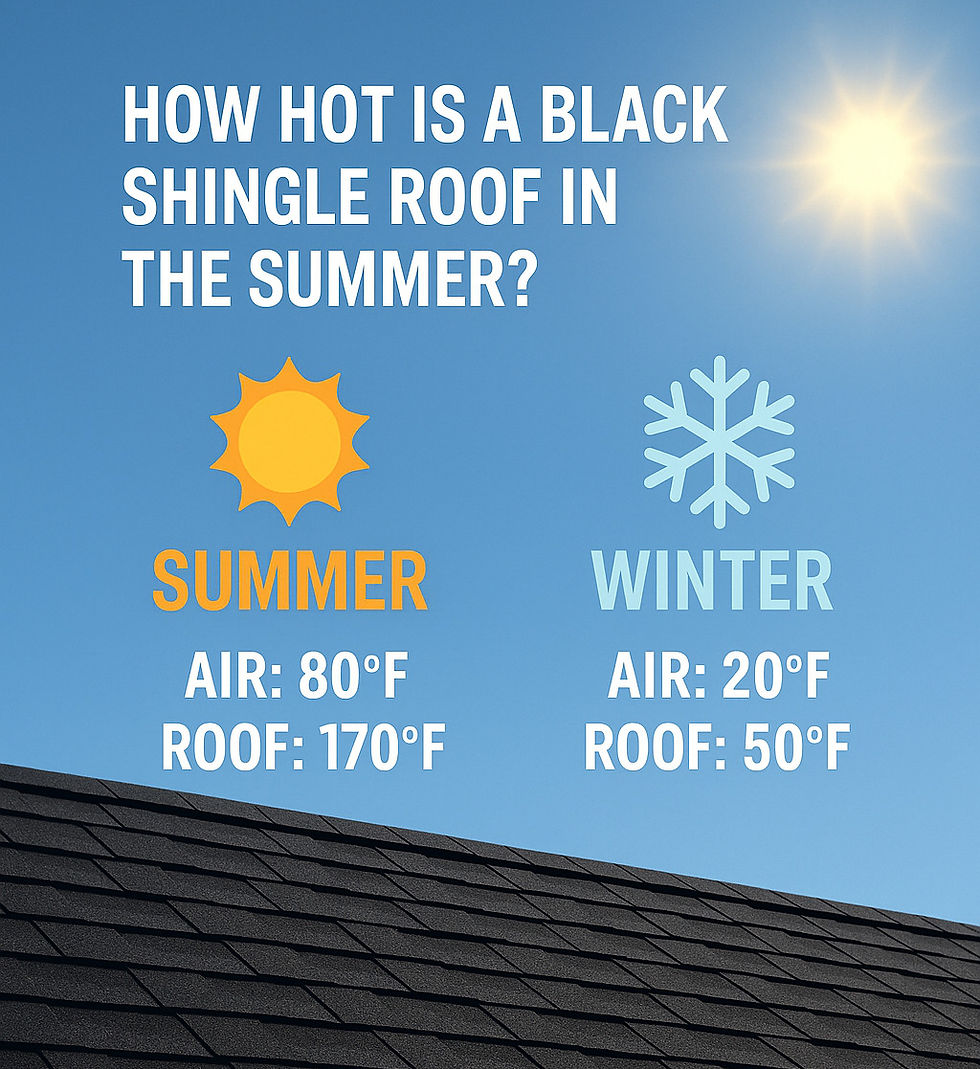Protect Your Roof from New England Heat and Winter Damage
- Refined Home Services

- Jul 21
- 4 min read
Updated: Sep 12
Understanding Seasonal Stress and Choosing the Right Roof Materials
If you’re a homeowner in New England, you already know: the weather doesn’t take it easy on your home. From blistering hot summers to brutal, snow-packed winters, your roof is constantly working overtime to protect everything beneath it.
But few people realize just how extreme the temperature shifts are and how much damage they can do to your shingles, attic, and long-term home value.
Let’s take a look at what really happens to your roof through the seasons—and how to choose materials that are built to handle the challenge.

Summer: Black Roofs Can Reach 170°F
New England summers aren’t always scorching, but when that sun is out, your roof can absorb a surprising amount of heat. Black or dark-colored asphalt shingles can heat up to 170°F, even when the air temperature is in the 80s. That kind of heat:
Bakes the shingles, causing premature aging and cracking
Superheats your attic, making AC work overtime
Can cause sealants to dry out and flashing to warp
This heat absorption can shorten your roof’s lifespan and drive up your cooling bills. Reflective or lighter-colored shingles can help—but so can the right materials beneath the surface, like underlayment and ventilation.

Winter: Freeze-Thaw Cycles, Ice Dams, and Hidden Damage
In January, it’s a different story. Roof surfaces can plummet below freezing overnight, especially when covered by a blanket of snow. However, on a sunny day, black shingles can warm up to 40–50°F, melting snow in some areas while other spots remain frozen.
This mismatch causes:
Ice dams—melted snow refreezes at the colder eaves, trapping water that can leak inside
Expansion and contraction that wear down shingles, nails, and flashing
Structural strain on older roofs, especially after years of repeated freeze-thaw cycles
The result? You might not notice the damage right away, but come spring, leaks and moisture issues can start to show.
Not All Shingles Are Created Equal
The good news? There are shingles—and full roofing systems—designed to minimize heat damage, resist cracking, and handle harsh New England winters. Here's how some of the top options compare:
Shingle Type | Best For | Heat Protection | Cold Durability | Ice Dam Resistance | Cost |
Cool Roof Shingles | Summer heat, energy efficiency | ⭐⭐⭐⭐ | ⭐⭐ | ⭐ | 💲💲💲 |
Architectural Shingles | All-around durability | ⭐⭐⭐ | ⭐⭐⭐⭐ | ⭐⭐ | 💲💲 |
Impact-Resistant | Storms, snow, hail | ⭐⭐ | ⭐⭐⭐⭐ | ⭐⭐⭐ | 💲💲💲💲 |
SBS-Modified Asphalt | Cold climates, flexibility | ⭐⭐⭐ | ⭐⭐⭐⭐⭐ | ⭐⭐⭐⭐ | 💲💲💲💲 |
Metal Roofing | Long lifespan, snow shedding | ⭐⭐⭐⭐⭐ | ⭐⭐⭐⭐⭐ | ⭐⭐⭐⭐⭐ | 💲💲💲💲 |
1. Cool Roof Shingles (Solar Reflective)
What they do: Reflect more sunlight and absorb less heat.
How they help: Reduce attic temperatures by up to 20–30°F, lowering AC costs and extending shingle life.
Example: Owens Corning TruDefinition® Duration® COOL, CertainTeed Landmark Solaris.
⚠️ Often required in warm climates, but useful in sunny New England summers too.
2. Architectural/Dimensional Shingles
What they do: Thicker, more durable than basic 3-tab shingles.
How they help: Resist warping, cracking, and curling from temperature swings better than thinner shingles.
Bonus: Better wind and impact resistance during storms and freeze-thaw cycles.
3. Class 4 Impact-Resistant Shingles
What they do: Built to withstand hail, debris, and ice.
How they help: More durable in freeze/thaw conditions and snow weight—reducing cracking and granule loss.
Example: CertainTeed NorthGate® SBS-modified asphalt shingles.
4. SBS-Modified Asphalt Shingles (Rubberized)
What they do: Blend rubberized polymers with asphalt.
How they help: Flex better during extreme heat and cold, reducing cracks and splits over time. Great for New England winters.
Example: Malarkey Legacy®, or CertainTeed NorthGate®.
5. Metal Roofing
What it does: Metal roofs reflect solar heat and shed snow quickly.
How it helps: Long lifespan, minimal ice damming risk, and doesn't crack with cold. But it's more expensive upfront.
Choosing What’s Right for You
If you're wondering which roofing material is best for your home, here are a few tips:
Budget-friendly + durable? Go for architectural shingles. They hold up better than basic 3-tab and are cost-effective for most homes.
Worried about harsh winters? SBS-modified shingles are rubberized and flexible, making them perfect for New England freeze-thaw cycles.
Looking for long-term protection? Metal roofing is a bigger investment upfront, but it sheds snow quickly, doesn’t crack, and can last 40–70 years.
Concerned about attic heat? Consider cool roof shingles or talk to a roofer about better insulation and attic ventilation.
Don’t Forget the Rest of the Roof System
Choosing the right shingles is important—but they’re just one part of the story. In New England, your roof system should also include:
Proper attic ventilation to reduce temperature swings
Ice & water shield underlayment at roof edges
High-quality flashing and ridge vents
Adequate insulation in the attic to keep warm air inside in winter
A roof that’s designed to breathe and move with the seasons will outlast one that isn’t.
Final Thoughts: Is Your Roof Ready for Another Year?
Between summer heat and winter snow, New England homes face some of the most challenging roofing conditions in the country. If your shingles are more than 15 years old—or if you’ve seen signs of curling, granule loss, or ice dams—it’s time to schedule an inspection.
Our team at Refined Home Services specializes in roofing that’s built for this climate. We’ll assess your current setup, recommend smart upgrades, and walk you through materials that actually match your budget and your weather.
Message us today for a free, no-obligation roof evaluation. Your future self will thank you—especially next January.


